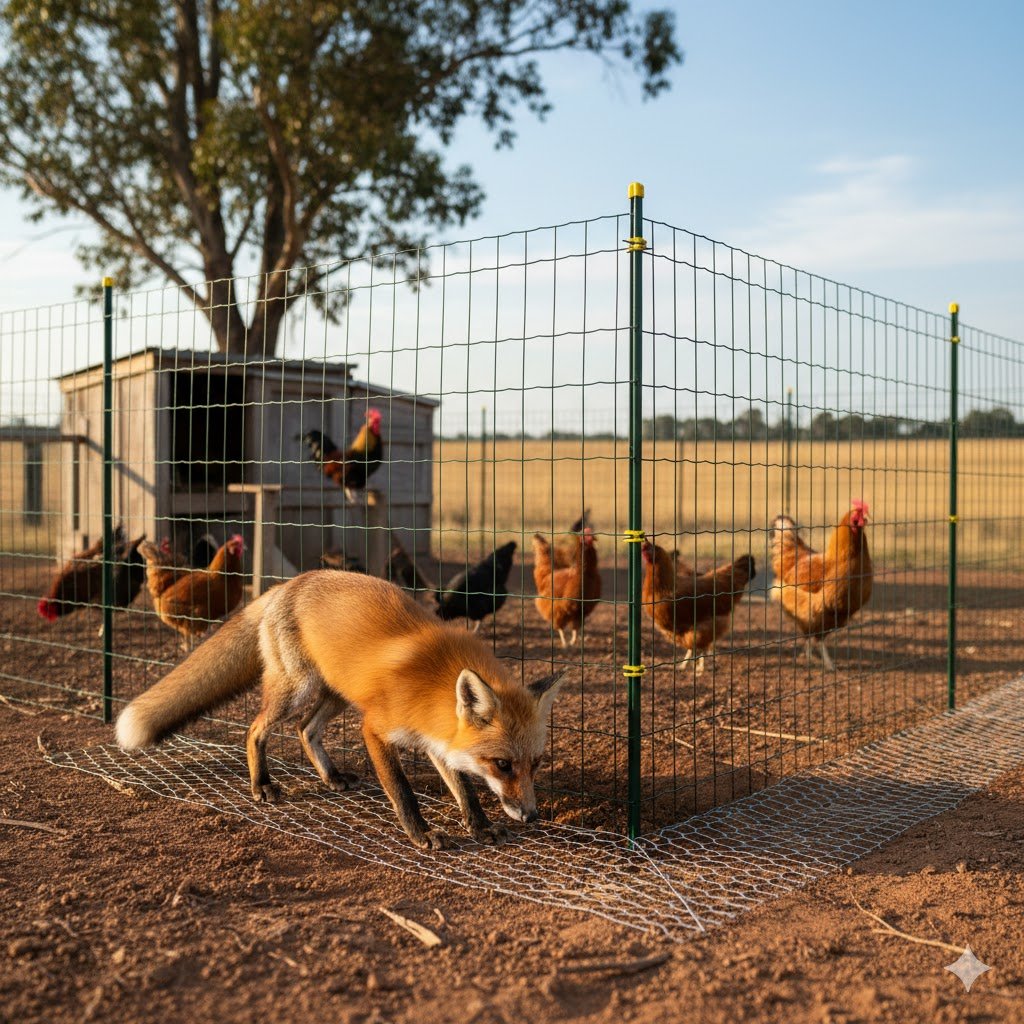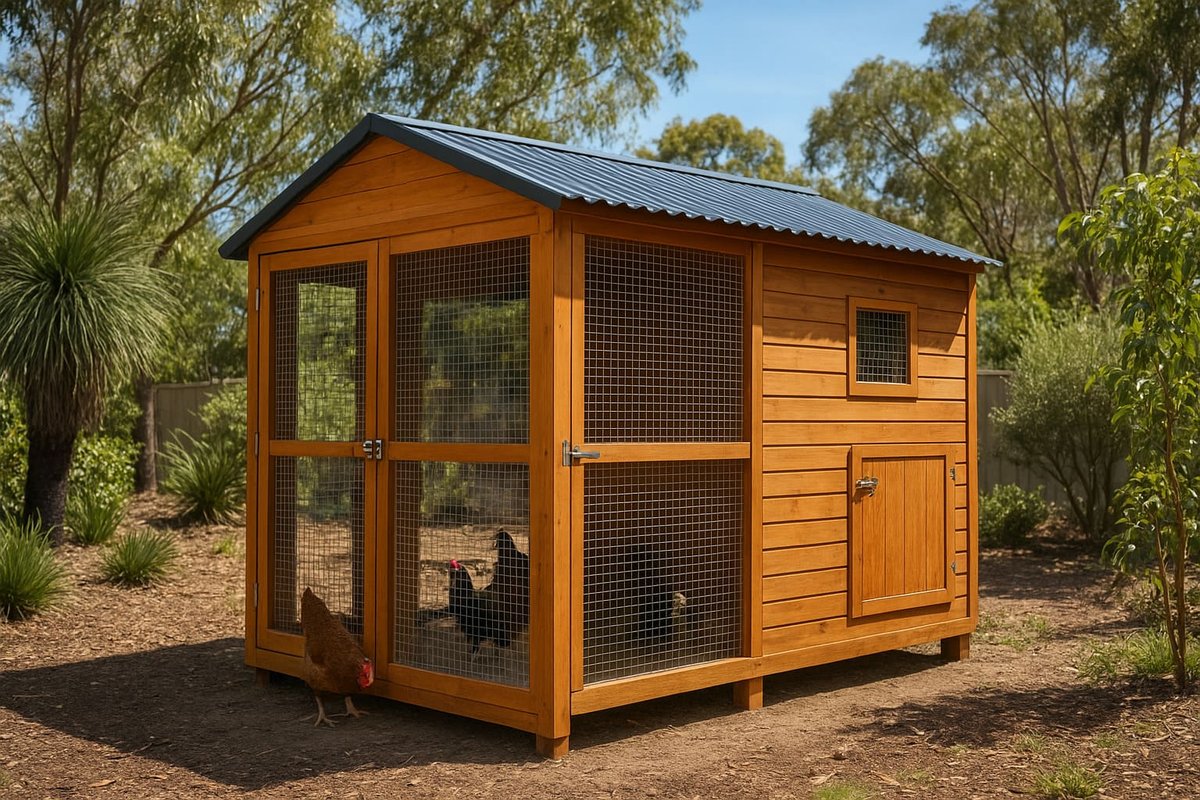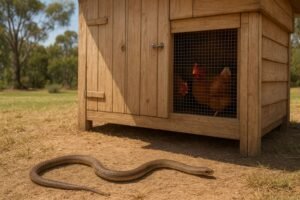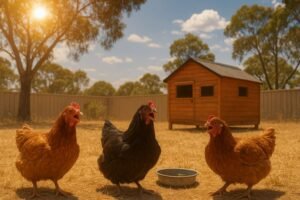Keeping backyard chickens in Australia is a real joy. But, making sure your flock is safe from predators is a big part of the job. From big goannas to clever foxes, many animals see your chickens as an easy meal. This guide will show you how to protect your flock from Australian predators with practical, easy steps.
What Animals Kill Chickens in Australia?
The first step to protecting your chooks is knowing what you’re up against. Australia has many predators, and they hunt in different ways. Knowing their methods is the key to stopping them.
The Fox (The Night-Time Threat)
The fox is the number one predator for many chicken owners. They are clever, can climb fences, and can get through surprisingly small gaps.
- How they hunt: Foxes are most active at night, from dusk till dawn. They will dig under flimsy runs, test latches, and can chew through weak chicken wire.
- Signs of a fox: A pile of feathers is the most common sign. Foxes often carry the bird away to their den. They also commit “surplus killing,” where they kill the whole flock but only take one or two birds.
Goannas (The Tank)
These large lizards are strong climbers and diggers.
- How they hunt: Goannas use brute force. They are mostly after chicken eggs but will take young birds or even adult chickens if they get the chance. They can tear open weak wire and climb walls or trees to get into a run from above.
- Signs of a goanna: Missing eggs are the biggest clue. You may also find large, three-toed tracks or claw marks on the coop.
Birds of Prey (Eagles, Hawks & Kookaburras)
Australia has many birds that will prey on chickens, especially in open areas.
- How they hunt: Wedge-tailed eagles and other large hawks can swoop down and take a full-grown chicken. Kookaburras are a danger to small chicks, which they will snatch from the yard.
- Signs of birds of prey: You may hear your flock make a loud, specific alarm call. Often, the bird is just gone without a trace, or your flock will be panicked and hiding.
Snakes (The Silent Thief)
Carpet pythons and other snakes are experts at getting into coops.
- How they hunt: Snakes can fit through any gap as big as their head. They come in to steal eggs (which they swallow whole) or chicks.
- Signs of a snake: Missing chicks or eggs are the main sign. You might also find a snake sleeping in a nesting box, trying to digest its meal.
Quolls (The Protected Predator)
These native marsupials are fast, agile climbers.
- How they hunt: Quolls often kill with a quick bite to the head or neck. Like foxes, they can also surplus kill, leaving several dead birds.
- Signs of a quoll: Multiple dead birds with neck or head injuries. Because quolls are a protected species, you must focus on prevention, not removal.
Feral Cats & Domestic Dogs
Never underestimate these common animals.
- How they hunt: Feral cats will hunt chicks, but a neighbourhood dog (even your own) can be the most destructive. A dog playing can destroy a flimsy coop and kill an entire flock in minutes.
- Signs of a dog: A scene of total destruction. The coop wire will be torn, and birds will be scattered.
Knowing your enemy is the first step. Now that you can spot the signs of these predators, let’s build a fortress to keep them out for good.
How to Protect Your Flock from Predators
The best defence is a good, strong setup. A few simple routines can make all the difference. Here is a step-by-step guide to building a predator-proof chicken coop, based on expert husbandry and management principles from Poultry Hub Australia. Our predator proofing 101 guide has even more quick fixes.
1. Build a Secure Chicken Coop
Your coop is where your chickens sleep. It must be their fortress, meeting high standards for animal welfare. Both the RSPCA’s standards and the official Australian Animal Welfare Standards for Poultry stress that secure housing is critical for protecting birds from predators and distress. When planning, consider how much space your chickens really need and the best place to put your chicken coop for safety.
- Solid Floor: Use a solid floor (wood, concrete) or lay heavy-gauge wire mesh under the floor. This is the best way to stop animals from digging in.
- Strong Latches: Use latches that need two steps to open, like a slide bolt with a carabiner clip. Clever foxes can learn to nudge simple latches.
- Ventilation Gaps: All ventilation holes must be covered with 10mm x 10mm welded wire mesh. A hole for air is also a door for a snake or quoll.
- High Perches: Make sure perches are high off the ground. Chickens feel safest when roosting high up. You can read more on how high roosting bars should be.
2. Use the Right Wire Mesh
This is the most common mistake new owners make. Standard “chicken wire” is only good for keeping chickens in. It will not keep predators out.
- Use 10mm Welded Wire Mesh: You need 10mm x 10mm welded wire mesh (or “hardware cloth”) on all windows, vents, and openings. A fox can chew through chicken wire, and snakes or quolls can slip right through it.
- Secure the Run: For the chicken run, use strong, galvanised wire. You must bury it at least 30cm deep. A covered run also adds a vital layer of protection from above.
- Create a “Wire Apron”: The best method is to bend the wire outwards at the bottom (in an “L” shape) and bury it 30-40cm underground. When a fox or goanna tries to dig, they hit the wire and give up.
3. Set Up Electric Poultry Fencing
For free-ranging chooks, electric poultry netting is a very effective animal protector.
- How it works: It gives a short, sharp shock that teaches foxes, dogs, and goannas to stay away. It is a powerful psychological barrier.
- Pro Tip: You must keep the grass trimmed low around the base of the netting, or the grass will touch the wires and short out the fence.
4. Use Lights and Alarms
Predators like to hunt in the dark and hate surprises.
- Motion Sensor Lights: A sudden bright light can scare off a fox or quoll. Place them at chicken-coop height, pointing at the most likely entry points.
- Predator Alarms: You can also get small, solar-powered alarms. Many flash red lights that mimic the eyes of another predator, which can frighten animals away.
5. Lock Up Your Flock at Night
This is the most important daily routine, as recommended by the RSPCA’s essential tips for chicken care. If you struggle with this, our guide on how to get chickens back in the coop at night can help.
- Make sure all your chickens are safely inside the secure coop every single night before dusk. Count them.
- Lock the door properly with your two-step latch. Foxes are most active from dusk until dawn.
- Consider an Auto-Door: If you work late, you can buy an automatic chicken coop door. They work on a timer or a light sensor and are a great investment. We’ve reviewed the best automatic chicken coop doors for Australians.
6. Keep the Area Clean
Don’t send an open invitation to predators. Good hygiene and biosecurity are key parts of responsible chicken ownership, as outlined by government resources like the NSW DPI and Poultry Hub Australia.
- Store Feed Securely: Keep all chicken feed in sealed, metal bins. Spilled food attracts rodents, so learning how to keep rats out of the chicken coop is a critical predator-prevention step.
- Collect Eggs Daily: Don’t leave eggs in the coop overnight. This is a major attractant for goannas, snakes, and quolls.
- Keep Grass Short: Mow the grass around the coop and run. Long grass gives snakes and foxes a place to hide.
- Remove Rubbish: Get rid of any piles of wood, old iron sheets, or junk near the coop. This also helps with natural ways to keep parasites out of your coop.
A strong coop and good daily habits are your core defence. But sometimes, you need a specific plan to target a specific pest that’s giving you trouble.
How to Keep Goannas Away from Chickens

To keep goannas away, you need to make your coop and run uninviting. The best way is to secure your run with strong wire mesh on the top as well as the sides, as goannas are excellent climbers.
- Secure the Roof: A fully enclosed, covered run is the only 100% effective way to stop a goanna or a large eagle.
- Block Climbing Spots: Trim any tree branches that hang over the run.
- Make Surfaces Slippery: If your coop is on stilts, you can wrap the posts in a smooth metal or plastic sheet to stop them from getting a grip.
- Remove Attractants: This is critical. Collect eggs every morning, and never leave food scraps or pet food out.
Goannas are a tough daytime problem, but the biggest threat for most Aussie chicken keepers arrives after dark.
How to Protect Chickens from Foxes in Australia

Foxes are the biggest threat to backyard chicken safety in Australia. They are smart, relentless, and will test your coop for any weakness, as detailed in practical guides like this one from Somerzby.
Signs of a Fox Attack
- Missing Birds: Often, there are few signs left, maybe just a pile of feathers. The fox will carry the bird off to its den to feed its young.
- Surplus Killing: A fox will often kill multiple chickens and leave them. This is known as “surplus killing.” They get into a killing frenzy and cache the bodies to come back for later.
- Burrowing: Look for signs of digging around the base of the coop or run.
- Feather Piles: A pile of feathers in a secluded spot is a classic sign of a fox attack.
Night-Time Security is Key
- Your coop must be locked tight every night without fail. A solid floor or the buried wire “L-shape” skirt (apron) is your best defence against digging.
- Electric poultry fencing is a powerful deterrent that teaches a fox that your coop is not worth the effort.
Securing your coop against a digging, climbing fox will also go a long way to helping you deal with Australia’s silent, slithering predator.
Snake Proof Chicken Coop Australia

To make a snake-proof chicken coop, you must focus on small gaps. A snake can get through any hole it can fit its head through. This is such an important topic, we have a full guide on how to snake-proof your chicken coop in Australia and another on the best snake-proof chicken coop designs.
1. Use 10mm Mesh (or smaller)
This is the most important rule. You must use 10mm x 10mm (or even 6.5mm) welded wire mesh on all openings, including windows, vents, and any small gaps. Seal every crack and hole in the coop walls and floor.
2. Create a ‘Clean Zone’
Snakes hate crossing open, exposed areas.
- Mow the grass right down in a 3-metre (10-foot) buffer zone around your entire coop and run.
- Remove all rubbish, woodpiles, and corrugated iron sheets from near the coop. These are “snake hotels” that give them a safe place to hide.
3. The Rodent-Snake Connection
This is the secret to snake control: If you have a mouse problem, you will soon have a snake problem.
- Snakes are not just drawn in by eggs; they are drawn in by the rats and mice that come to eat spilled chicken feed.
- Keep all your chicken feed in secure, metal, rodent-proof bins. This is the number one tip for keeping rats out of your coop.
- Clean up any spilled feed immediately.
While snakes are a reptile risk, their larger lizard cousins, the goanna, raise different questions for backyard owners.
Do Goannas Keep Snakes Away from Your House?
This is a common myth. While a goanna might eat a snake if it gets the chance, you cannot rely on one to protect your property.
- They are Competitors: Goannas eat the same things as snakes (eggs, chicks, rodents).
- They are Predators: A goanna is a direct threat to your flock. It will eat your eggs and chickens.
- The Verdict: Do not encourage goannas. They are not a “guardian” for your chooks; they are a threat.
It’s clear you can’t rely on one predator to handle another. And when you see a goanna, you need to act safely and responsibly.
What to Do If You See a Goanna
Goannas are native Australian animals and are protected by law. It is illegal to harm, kill, or trap them without a permit.
- Keep Your Distance: Do not approach it. They have sharp claws, a nasty bite (with a lot of bacteria), and a powerful tail.
- Secure Your Chooks: Make sure your chickens are locked in their secure run.
- Do Not Feed It: This is the worst thing you can do. It teaches the goanna that your backyard is a food source, and it will keep coming back.
- Scare it Off (Safely): Making a loud noise from a safe distance (like banging a pot) can sometimes scare it away.
- Call a Professional: If a goanna is trapped (e.g., inside your run) or won’t leave, call your local wildlife rescue organisation (like WIRES) for advice.
Goannas are a protected native, but so are quolls, which brings a different set of challenges for chicken keepers.
How Do Quolls Kill Chickens?
Quolls are small but effective predators. Because they are a protected native species, you must not harm them. All your efforts must be on prevention.
- How they kill: They are fast, agile climbers. They often kill with a quick bite to the head or neck and can also surplus kill, leaving several dead birds.
- Their size is deceptive: They can squeeze through very small holes.
Quoll-Proofing Your Coop
Quoll-proofing is identical to snake-proofing.
- 10mm Mesh: Use 10mm x 10mm welded wire mesh on all gaps and vents. This is the single most effective action.
- Lock Up: Secure your flock in the coop every night.
- Clean Feed: Store all feed in metal bins to keep rodents away, which quolls also hunt.
Quolls and foxes share a nasty habit of killing more than they eat. But will a fox keep coming back for more after an attack?
Will a Fox Come Back After Killing Chickens?
Yes, 100%. Once a fox finds an easy, reliable food source (your chickens), it will “map” your coop and return again and again. It will teach its young where your coop is.
- A fox attack is not a one-time event. It is the start of a problem.
What to Do Immediately After a Fox Attack
If you find injured birds, it’s important to act fast. This is why we recommend learning how to set up a chicken first aid kit before you need one.
- Find the Entry Point: Do not do anything else until you find out how it got in. Did it dig under? Climb over? Break a latch? Squeeze through a rotten plank?
- Fix and Upgrade: Fix the weak spot immediately. Don’t just patch it; upgrade it. If it dug under, lay a wire apron. If it broke a latch, install a two-step bolt.
- Remove Carcasses: A fox will come back for the birds it left behind. Remove any dead birds from the area. Do not bury them nearby, as the fox will smell them and dig them up.
Foxes are a common problem, but many owners have other specific questions about them and the other predators on our list.
Seasonal & Local Tips for Predator Protection

- Winter: Food is scarce in winter. Foxes and quolls may become bolder and take more risks to get a meal. Rodents will also try to move into your coop for warmth and food, bringing snakes with them on warmer days. Be extra careful with your nightly lock-up and read our winterizing chicken coop guide for more tips.
- Summer: This is when snakes and goannas are most active. Keep your grass mown short and be extra vigilant about collecting eggs daily. Birds of prey are also raising their own young and will be hunting more actively.
- Local Advice: Talk to your neighbours or local poultry club. They will know the specific predator risks in your exact area. If you live near bushland, quolls and goannas are a bigger risk. If you’re in a semi-urban area, foxes and stray dogs are your main problem.
It’s a lot to remember, so let’s finish with a simple checklist you can use to keep your flock safe every day.
Your Final Predator-Proof Checklist
Daily
- Let chooks out in the morning.
- Collect all eggs.
- Lock chickens in the secure coop before dusk.
- Check feed and water, ensuring no spillage.
Weekly
- Walk the perimeter of the run. Look for any signs of digging, loose wire, or new holes.
- Check that all latches and locks are working.
- Clean up any spilled feed and droppings from around the coop.
- Perform a quick chicken health check on your flock.
Seasonally
- Mow all long grass and clear brush from around the coop.
- Check the wire mesh (especially the buried part) for rust or damage.
- Repair any holes or weak spots in the coop wood or structure.
Frequently Asked Questions (FAQ) on Protecting Your Flock from Australian Predators
What are the signs of a fox killing chickens?
The most common sign is a pile of feathers and not much else. Foxes often carry the chicken away. They may also kill several chickens and leave the bodies, often with bites to the neck and chest.
Why were foxes introduced to Australia?
Foxes were introduced to Australia in the 1850s for recreational hunting. Unfortunately, they spread quickly and have had a devastating impact on native wildlife and livestock.
How to keep foxes away from poultry?
The best ways are a “system” of:
A strong coop with a solid floor, locked every night.
10mm welded wire mesh (not chicken wire) on all gaps.
Burying mesh 30cm deep and 30cm out (L-shape) to stop digging.
Electric poultry fencing.
Motion-sensor lights.
What is the number one predator of chickens?
In Australia, the fox is generally considered the number one predator of backyard chickens, especially near urban areas.
Do Kookaburras really kill chickens?
Yes, but only small, young chicks. A kookaburra is not a threat to an adult bird. If you have chicks, you must keep them in a fully-enclosed brooder or run with a mesh roof.
What’s the best animal protector for chickens?
There is no single “best” thing. The best protection is a system: a secure coop + strong wire mesh + good habits (like locking up at night). For those on larger properties, a “guardian animal” like a Maremma dog, which lives with the flock, is an excellent full-time protector, but this is a very big commitment.
These answers cover the basics, but you should also know that predator risks can change with the seasons.
Conclusion
Protecting your flock is an ongoing job, not a one-time task. The best defence is always a layered “system” of security. This means a strong coop, the right wire mesh, and good daily habits work together to create a safe home for your chickens. By understanding the predators in your specific area and checking your setup regularly, you can relax and enjoy the best parts of keeping backyard chooks: fresh eggs and happy, healthy birds.
With your main defences sorted, it’s also smart to think about how the time of year can change the risks your flock faces.

Oladepo Babatunde is the founder of ChickenStarter.com. He is a backyard chicken keeper and educator who specializes in helping beginners raise healthy flocks, particularly in warm climates. His expertise comes from years of hands-on experience building coops, treating common chicken ailments, and solving flock management issues. His own happy hens are a testament to his methods, laying 25-30 eggs weekly.



